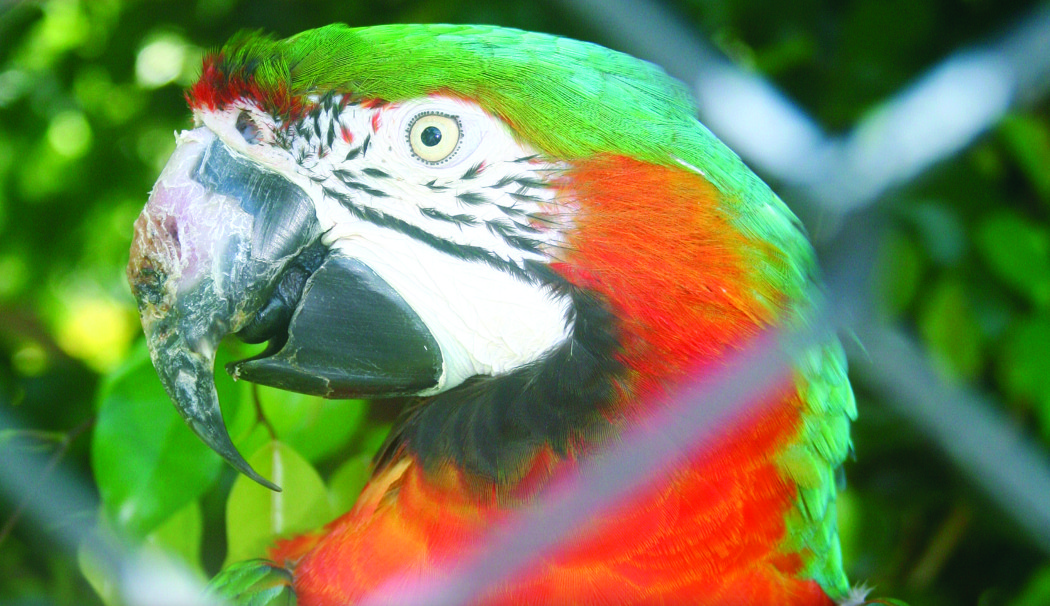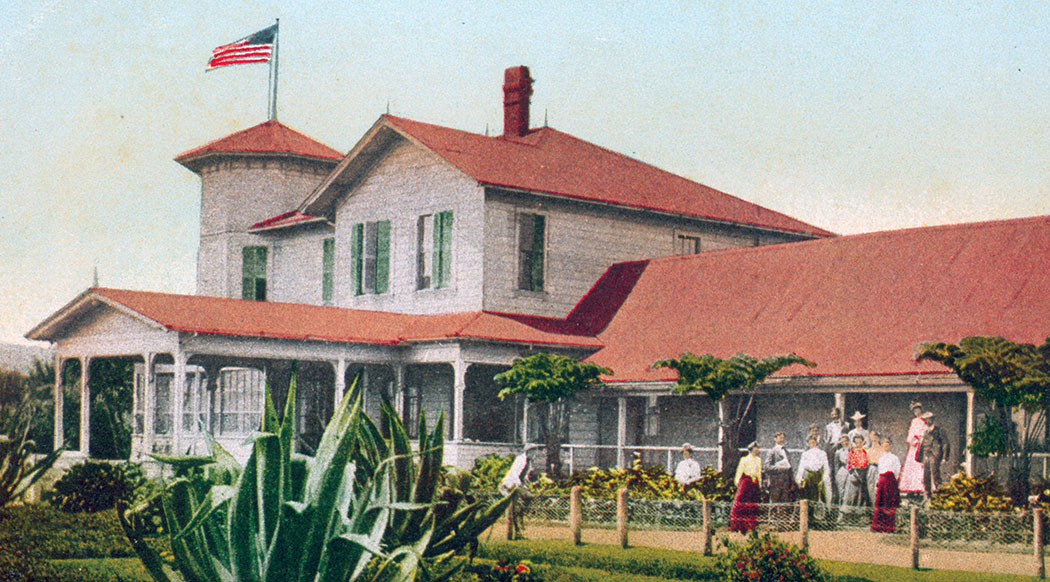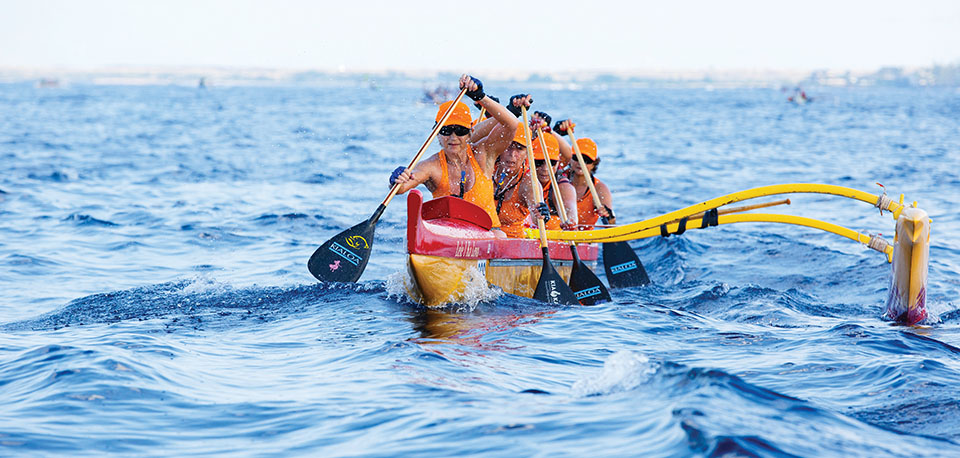
The Parrots of Pana‘ewa
 By Alan D. McNarie
By Alan D. McNarie
It’s noon on a Wednesday at the Pana‘ewa Rainforest Zoo in Hilo, and Jan Comstock and Zoe are having some quality time at a picnic table.
Let’s play “find the nut,” says Jan.
“Mac nut,” says Zoe, emphatically. Only it sounds more like “Nyak nut.” Sort of a cross between “mac nut” and Curly of the Three Stooges laughing. Zoe has a little trouble with ‘m’s—probably something to do with having no lips.
Jan hides a mac nut under a towel on the table. Zoe quickly locates it and throws the towel aside.
“Good job, Zoe!” exclaims Jan, as Zoe gnaws delicately on the nut.
Zoe acts a lot like a three-year-old. Her vocabulary is limited, she throws things a lot, she’s curious about everything, and she loves attention. She is actually a hyacinth macaw, the largest member of the parrot family: a magnificent, three-foot-long, vibrant blue bird—her feathers are actually blue on top, black underneath—with a ring of brilliant yellow around each coal-black eye. She’s five years old and came to the zoo two and a half years ago. Jan is an “enrichment volunteer”: one of 11 or so people who provide exercise and mental stimulation for the zoo’s animals. She’s been working with Zoe for about two and a half years.
“The vet who was involved with her offered a series of classes for members of the enrichment teams who wanted to work with her,” Jan explains. She and another volunteer, Barbara, finished the class and became Zoe’s special friends.
The remarkable thing about the “find the nut” game is that Zoe isn’t just mimicking a human word. She knows what a mac nut is, and she uses the words to communicate her wishes. That’s what linguists call a “referential utterance”: one of the cornerstones of language use.
Zoe makes her understanding of words even clearer a minute later. On the way to the picnic table, Jan proudly explains about another of Zoe’s accomplishments: she can open a snack-sized box of raisins.
“She doesn’t tear it up,” Jan says. “She really politely opens the lid. She takes out one and she peels it and eats it. Then she takes out another one and peels it. Then I take the box away.”
Now, Jan pulls out one of those little boxes of raisins. But Zoe takes the box in her beak and tosses it aside.
“Nyak nut,” she repeats.
Her vocabulary goes beyond nuts. She also clearly recognizes the name of another game Jan plays with her. When Jan puts the towel over her head, Zoe gleefully cries “Peek-a-boo!” and pulls the towel off.
Zoe’s not the only parrot at the zoo who uses words for more than mimicry. In a large cage near the zoo’s entrance is another of its stars: a Catalina macaw named Max. If Zoe is a study in monochromatic blue elegance, Max is just the opposite: he’s a gaudy riot of color, with an orange breast, sky blue wings and blue, green and yellow back and tail feathers. It isn’t his looks, however, that make him special. It’s his vocabulary and how he uses it. He knows scores of words, including the names of several past and present zookeepers. He doesn’t just say “hello”; he says it with several different inflections — as well as “Hi,” “How are you,” and ”Well, hello.” He also clearly has assigned meanings to some words. His word for treats, for instance, is “cookie.” Originally, it was literally cookies; he used to eat Oreos, unscrewing them and eating the middle first, just like kids do, until his vet put a stop to that practice. Now he uses the word for almonds.
Max is in the front of his cage one day, chatting with this writer and a couple of other visitors, when zookeeper Dan Green stops by with a bag of almonds. Max’s attention immediately shifts.
“Have a cookie,” he says. Green obliges him.
Max has apparently also learned the meaning of raising his voice. “I’m sitting at the desk [in the nearby zoo office] and he says, “Come here,” Greene relates. “I don’t get up, and he says, ‘COME HERE!”
Zoo Director Pam Mizuno has had the same experience, with an extra punchline. Shortly after she took her current job, she says, she was sitting in her office when Max pulled his “come here” routine on her. When she finally responded, he looked her over and then said, “Well, how are you?”
In a cage next door to Max is one of the zoo’s most recent acquisitions: a yellow-headed Amazon parrot named Salsa. Max and Salsa hold long conversations with each other—in English—though the subject matter is admittedly limited. Mostly they just shout “hello” back and forth to each other, though sometimes it’s the name of some human they know or have known.
Salsa has another talent. He sings human songs, on key and in time.
“Salsa sings ‘Blue Skies,’” remarks another zoo volunteer named Evelyn. “He knows all the words.” She also recalls a time when she heard him singing “Over the Rainbow”: “He got to ‘Birds fly over the rainbow,’ and then stopped, like he was thinking about it….” Unfortunately, Salsa is a little shy, so he usually only sings when it’s raining or the zoo is closed.
Parrots are widely considered to be among the smartest of all birds. An African grey parrot named Alex, trained over 30 years by mainland animal psychologist Irene Pepperberg, learned and used hundreds of words and even mastered some human syntax; she could use words not only to distinguish objects, but to describe their color and texture; she recognized numbers up to six and could do simple addition; she even used the words, “I’m sorry,” if she sensed a human colleague was frustrated. Just how parrots accomplish their mental gymnastics is one of science’s great mysteries. They have big brains by bird standards, but Zoe’s brain is still only about the size of one of her beloved mac nuts. If mammal brains were as efficiently wired as Zoe’s, then lemurs would be reciting Shakespeare.
Parrots’ cleverness, as well as their beautiful colors, work both for and against them when humans are involved. Zoe’s relatives in their native Amazon habitat are now considered endangered, partly from habitat loss and also due to the pet trade. The same can be said for Salsa and many of the other parrots at the Hilo zoo: Those that aren’t endangered are generally either threatened or, as least, suffer from shrunken ranges in the wild. It’s now illegal to capture and import most species of wild parrots, though many are being successfully bred in captivity.
And their cleverness can work against them in captivity as well. Zoe, Max and Salsa all share similar histories. Before Salsa was donated to the zoo last January, she was hand-raised and kept as a pet by a family for 15 years—until some construction happened next door, and he learned to imitate the back-up beep of a truck. It became so annoying that the family gave him to the zoo. Max was donated when his owner left for the mainland. Before the zoo purchased Zoe, she’d been kept by two different families. The first family, Jan says, “found that they couldn’t devote enough time to her, so they sold her to a second family, who found the same thing.”
In fact, most of the zoo’s parrots were given away by owners who found they were no longer up to the responsibilities of parrot ownership. During this interview in Mizuno’s office, she got yet another call from an owner who wanted to give her bird to the zoo. Mizuno had to decline; the zoo has no more space.
Some of those unwanted birds end up in the care of Dorothy and Jerry Walsh, who run the Parrots in Paradise bird sanctuary in Kealakekua. The sanctuary currently houses about 70 parrots of all sorts: Amazons, true parakeets, macaws, cockatoos, parakeets, Senegals, love birds, Pionus, African greys, Australian eclectus Lately, they’ve been getting an influx of conures, as people reconsidered their impulse buys from a local pet store.
“People think, Oh, I’m in a tropical paradise, and I’m gonna have this bird and it matches my sofa,” says Dorothy Walsh. “They have this dream of walking around with the parrot on their shoulder. And I say, ‘Oh like a pirate?’ I remind them that the pirates in the movies are usually wearing an eye patch.”
That’s one thing a prospective parrot-owner should consider. Parrots are vegetarians (it’s illegal to turn one loose, because they can become agricultural pests), but if they feel threatened, they are awesomely armed. Zoe’s knife-sharp beak is also one of the few tools in the animal world that can crack a mac nut shell (though she’s gotten lazy and only accepts them pre-shelled). Her talons, though designed for grasping tree branches, would do a hawk credit; she has to have them blunted so she won’t accidentally injure Jan and the other zoo volunteers. She’s quite considerate—one of the tricks that she performs for children at the zoo is a “somersault” where she drops under Jan’s wrist and comes back up the other side, all without injuring Jan’s bare arm—but even so, accidents occasionally happen. Jan recalls one Christmas when her daughter gave her a big toy for Zoe and “stocking stuffers” of Band-Aids and antibiotics.
“It was one of the best Christmases I’ve ever had,” she says.
A parrot can’t be bullied or ordered around like a dog or even a cat; there has to be a relationship of mutual respect. Dogs play fetch for their masters. Parrots often toss things so their humans will retrieve them. And their moods can be tricky to judge, if you’re not used to them. A parrot has no mobile mouth or eyebrow muscles to give its face expression. It shows emotion by, say, ruffling its feathers or vocalizing. If a macaw is really angry, notes Jan, its eyes “whirl around and that means it’s going to attack.” That’s never happened, fortunately, with Zoe. But with her black-on-black eyes, it would be difficult to spot the warning signs.
And parrots are not low-maintenance pets. They’re flock animals. Parrots hand-raised by humans “imprint” on them, basically adopting humans as their flock. Being away from their people is a high-stress experience that can lead to self-destructive behavior such as plucking out their own feathers.
“If they’re bonded to a human that has a 9-to-5 job, that’s a real problem,” says Walsh. “That’s a lot of lonely hours, and when the human gets home, that’s about time for the bird to hunker down.”
And then there’s the matter of longevity. Large parrots are one of the few species on earth that can outlive a human being: in captivity, they often survive from 50 to 80 years, depending on the species, and 100-year-old birds are not unheard of. Given that parrots are also expensive, people are usually at least in their 30s before they acquire one. If you own a parrot, you need to make provisions for it in your will.
Children are another consideration. Parrots really do resemble human toddlers; most of Zoe’s toys are actually designed for children of that age. But Walsh doesn’t recommend parrots for people with small children, because the birds may see the kids as rivals.
So a good match for a parrot is a very special breed of person: a human who is willing to commit himself or herself to a decades-long relationship with an inquisitive toddler who never grows up. When someone approaches Parrots in Paradise about adopting a sanctuary bird, Dorothy screens them carefully and makes sure that they know what they’re getting into.
The flip side is a genuine companionship with a creative, intelligent, startlingly alien and yet startlingly empathetic creature. When Zoe and Jan are together, she often nuzzles against Jan’s shoulder in an obvious expression of affection. Jan recalls one day when she came to the zoo but “was not feeling perky. She sensed it, and all day she was cuddling me.”
And for those who want a taste of that relationship without the commitment, there’s always the zoo. I’m there one afternoon, and stop by Zoe’s cage just at closing time. We play one of Zoe’s games: When you say “good bye,” or wave at her, she waves her claw back at you.
It’s not just a game. When I say, “good-bye, Zoe,” a final time and start to walk away, she waves her claw even more frantically and squawks in distress.
Don’t worry, Zoe. I’ll be back. ❖
Contact writer Alan McNarie at amcnarie@yahoo.com.
Parrots in Paradise is seeking people to adopt birds, and both Parrots in Paradise and the Pana`ewa Rainforest Zoo welcome donations and volunteers. For more information:
Pana`ewa Rainforest Zoo: www.hilozoo.com
Parrots in Paradise: www.parrotsinparadise.com/parrotst.aspx


